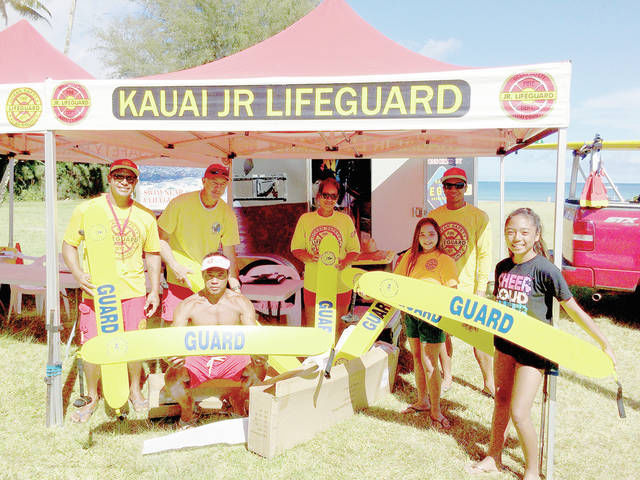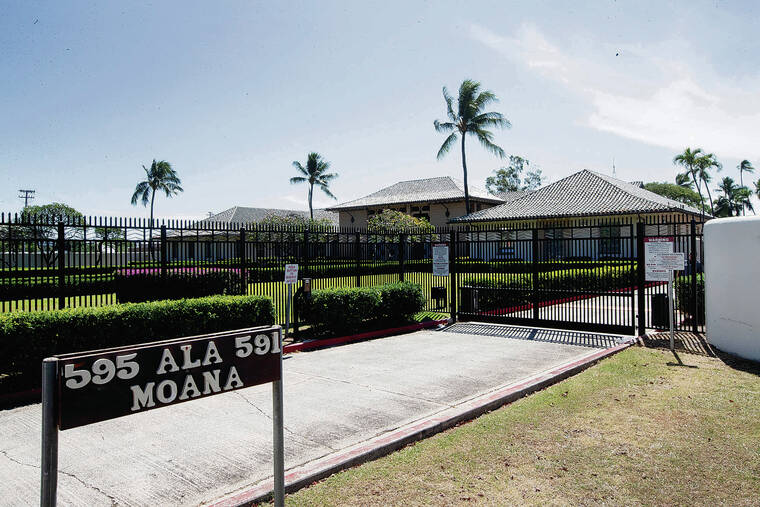HANALEI — If kids know how to use the yellow rescue tubes placed on beaches around the island, they can help save lives.
“We have hundreds of Kauai’s keiki out there trained in water safety, and know they’re going to be safe and that they understand rip tides and currents,” said Branch Lotspeich, executive director of the Rescue Tube Foundation. “They’re likely to use it if they have to go save a friend or parent, which has happened before.”
That’s why the foundation donated eight tubes, also known as personal flotation devices, to the Junior Lifeguard Program.
“It’s good for them to know how to use it,” Lotspeich said. “It’s excellent to be able to get these in the hands of Junior Lifeguards.”
Earlier this month, Lotspeich dropped off the tubes during Junior Lifeguard training at Hanalei Bay.
“We would like to take this opportunity to extend our sincere mahalo to the Rescue Tube Foundation for their generous donation of eight rescue tubes to the Kauai Junior Lifeguard program,” said Kalani Vierra, supervisor of the Kauai Fire Department Ocean Safety Bureau. “Year after year, many young men and women are eager to participate in our Junior Lifeguard program to gain valuable skills that could one day be used to save a life.”
The program is split into two separate age groups — the Keiki Junior Lifeguard Program for kids aged 8-11, and the Junior Lifeguard Program for kids aged 12-17. The free program teaches ocean safety awareness and lifesaving skills.
Lotspeich decided to donate the tubes after receiving an order that wasn’t right.
“The printing was not correct. So rather than sending them back to the supplier, I decided I can put them to good use here,” he said. “It’s more important just to donate them.”
The Rescue Tube Foundation donated tubes to the program once before, after they decided to change the color of the tubes from red to yellow, Lotspeich said.
The foundation was incorporated as a nonprofit in 2010 after Lotspeich, a member of the Rotary Club of Hanalei Bay, heard about the effort to install rescue tubes at Kauai’s unguarded beaches. That effort is being spearheaded by the Kauai Lifeguard Association.
After raising $5,000 through the Rotary Club of Hanalei Bay, Lotspeich and his partner, John Gillen, decided to take it a step further and start the nonprofit.
“We started it because we saw an incredible lifesaving value of putting them out for family members and good Samaritans to use,” he said.
Currently, there are 230 rescue tubes around the island, including at Polihale State Park and Hanakapiai Beach.
What began as a project on Kauai soon turned into a state and national effort. The Rescue Tube Foundation has helped install the tubes on other Hawaiian islands and beaches and lakes in North Carolina, Florida, South Dakota and California.
“People can drown in three to five minutes, so by the time a Jet Ski or fire truck can get there, it’s quite a bit later, and unless you’re a good swimmer, it might end up being a body retrieval and not a rescue,” Lotspeich said.
The purpose of tube is to help protect the rescuer, he added.
“If you go without your own flotation device, you’re really putting yourself in harm’s way because they see you as a personal flotation device and climb on your shoulders,” he said.
The goal of the tubes is for the user to stabilize a person until help comes to them.
“The idea is to hold onto it, breathe again, but don’t try to come back in on their own,” he said.
Unless a person knows what they’re doing, they shouldn’t attempt to help a swimmer in distress, Lotspeich added.
“We do not encourage anyone to put them in harm’s way while using a rescue tube. Our instructions, the very first thing, says that if you can’t swim, do not go in water; do not use device,” he said. “Only people comfortable in water should use a rescue tube.”





